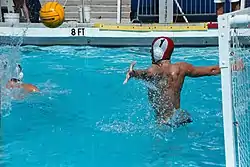Eggbeater kick
The eggbeater kick is a style of kicking where the swimmer's legs alternate one-legged breaststroke kicks.[1] This form provides continuous support because there is no break in the kick,[2] and allows the swimmer to remain stable in the water without swaying. However, it can cause knee problems due to the circular rotation of the knee joint.[3]
Applications
The eggbeater kick is used in several different types of swimming activities.
Sports

- Water polo players use this style of kick so their hands can be free to shoot, pass, dribble and control the ball. Water polo players need to perfect the eggbeater kick to have success. Goalkeepers must be able to do this especially as they need to have the power to get to the ball.[4]
- Synchronized swimming uses this style of kick so they can perform other important skills that require stabilization. The eggbeater kick allows the swimmers to lift teammates out of the water.
Lifesaving
- Lifeguards use this kick because it allows greater stabilization of the upper body and use of hands to rescue victims.
Technique
The eggbeater kick is an alternating breastroke kick. The steps for eggbeater are the same as in breast stroke, except you are doing one leg at a time.
1. Heel to butt, make sure you relax your foot on the way up 2. Turn your foot the outside of your body and flex 3. Kick out to the side 4. Point your foot and close
Physics
The eggbeater kick propels swimmers in an upward direction. The swimmer rotates his or her legs circularly while keeping their feet arched and angled, causing water above their foot to move faster than the water under their foot. This difference in pressure between the moving water and the surrounding water creates a force, propelling the swimmer upwards.[5][6] The faster the swimmer's feet move, the more upward propulsion he or she receives.[7]
References
- Mills, Glenn. "Training – Double Med-Ball Eggbeater." GoSwim! 16 Sept. 2008. Web. 03 Feb. 2011. <http://www.goswim.tv/entries/5430/training---double-med-ball-eggbeater.html>.
- "Treading Water." City College of San Francisco. Web. 26 Jan. 2011. <http://www.ccsf.edu/Resources/Faculty/dnagura/TreadingWater.htm>
- Franić, M; Ivković, A; Rudić, R (June 2007). "Injuries in water polo". Croat. Med. J. 48: 281–8. PMC 2080536. PMID 17589969.
- Nitzkowski, Monte. "The Swim Strokes and Water Polo: Chapter 2." Water Polo Planet: The Alternate Voice. Feb. 1998. Web. 18 Jan. 2011. http://www.waterpoloplanet.com/HTML_Monte_pages2/mn02_Learning_the_Basics.html
- "Fundamental Hydrodinamics of Swimming Propulsion (Jose M. Redondo) – Academia.edu." Universitat Politecnica De Catalunya – Academia.edu. Web. 27 Jan. 2011. <https://upc.academia.edu/JoseMRedondo/Papers/330707/Fundamental_Hydrodinamics_of_Swimming_Propulsion>.
- Alexander, Marion, and Carolyn Taylor. "CoachesInfo.com – Information and Education for Coaches – The Technique of the Eggbeater Kick." Coaches Info Service Website. 2005. Web. 18 Jan. 2011. http://www.coachesinfo.com/index.php?option=com_content&view=article&id=231:waterpoloeggkick&catid=70:waterpologeneralarticles&Itemid=131
- Dettamanti, Dante. "Dante's Water Polo Coaching Classes." Water Polo Planet. 1 Oct. 2010. Web. 01 Feb. 2011. <http://www.waterpoloplanet.com/HTML_Dante_pages2/dd09_Dante_Coaching_Class.html>.
